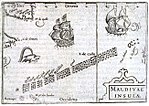
Back تاريخ المالديف Arabic মালদ্বীপের ইতিহাস Bengali/Bangla Història de les Maldives Catalan Geschichte der Malediven German Historia de Maldivas Spanish Malediivien historia Finnish Histoire des Maldives French A Maldív-szigetek történelme Hungarian Մալդիվների պատմություն HY Sejarah Maladewa ID
This article may require copy editing for grammar, style, cohesion, tone, or spelling. (March 2024) |
| History of the Maldives | ||||||||||||||||||||
|---|---|---|---|---|---|---|---|---|---|---|---|---|---|---|---|---|---|---|---|---|
 | ||||||||||||||||||||
| Pre-dynastic | ||||||||||||||||||||
| Dynastic ages | ||||||||||||||||||||
|
||||||||||||||||||||
| Modern history | ||||||||||||||||||||
|
||||||||||||||||||||
The history of the Maldives is intertwined with the history of the broader Indian subcontinent and the surrounding regions, comprising the areas of South Asia and the Indian Ocean. The modern nation is formed of 26 natural atolls, comprising 1194 islands. Historically, the Maldives has held strategic importance due to its location on the major marine routes of the Indian Ocean.[1] The Maldives's nearest neighbors are the British Indian Ocean Territory, Sri Lanka and India.[2][3] The United Kingdom, Sri Lanka, and some Indian kingdoms have had cultural and economic ties with the Maldives for centuries.[1] In addition to these countries, Maldivians also traded with Aceh and many other kingdoms in what is today Indonesia and Malaysia. The Maldives provided the primary source of cowrie shells, which were then used as currency throughout Asia and parts of the East African coast.[1] Most likely, the Maldives were influenced by the Kalingas of ancient India. The Kalingas were the earliest region of India to trade with Sri Lanka and the Maldives and were responsible for the spread of Buddhism. Stashes of Chinese crockery found buried in various locations in the Maldives also show that there was direct or indirect trade contact between China and the Maldives. In 1411 and 1430, the Chinese admiral Zheng He (鄭和) visited the Maldives. The Chinese also became the first country to establish a diplomatic office in the Maldives when the Chinese nationalist government based in Taipei opened an embassy in Malé in 1966. The Embassy of the People's Republic of China has since replaced this office.
After the 16th century, when colonial powers took over much of the trade in the Indian Ocean, politics in the Maldives were interfered with by first the Portuguese, then the Dutch, and the French.[4] However, this interference ended when the Maldives became a British Protectorate in the 19th century. The Maldivian monarchs were granted a measure of self-governance.
The Maldives gained total independence from the British on 26 July 1965.[5] However, the British continued to maintain an air base on the island of Gan in the southernmost atoll until 1976.[1] The British departure in 1976 at the height of the Cold War almost immediately triggered foreign speculation about the future of the air base.[1] The Soviet Union requested the use of the base, but the Maldives refused.[1]
The republic's greatest challenge in the early 1990s was the need for rapid economic development and modernization, given the country's limited resource base in fishing and tourism.[1] Concern was also evident over a projected long-term sea level rise, which would prove disastrous to the low-lying coral islands.[1]
- ^ a b c d e f g h Ryavec 1995, p. 257.
- ^ "Maldives". Commonwealth of Nations. Retrieved 26 June 2024.
- ^ "British Indian Ocean Territory". Government of the United Kingdom. Retrieved 11 May 2024.
The British Indian Ocean Territory has been under continuous British sovereignty since 1814. BIOT is close to the very center of the Indian Ocean, mid-way between Tanzania and Indonesia. Its nearest neighbours are the Maldives and Sri Lanka.
- ^ "History". Embassy of the Maldives, Brussels. Retrieved 26 May 2024.
- ^ Colliers Encyclopedia (1989) VO115 P276 McMillan Educational Company